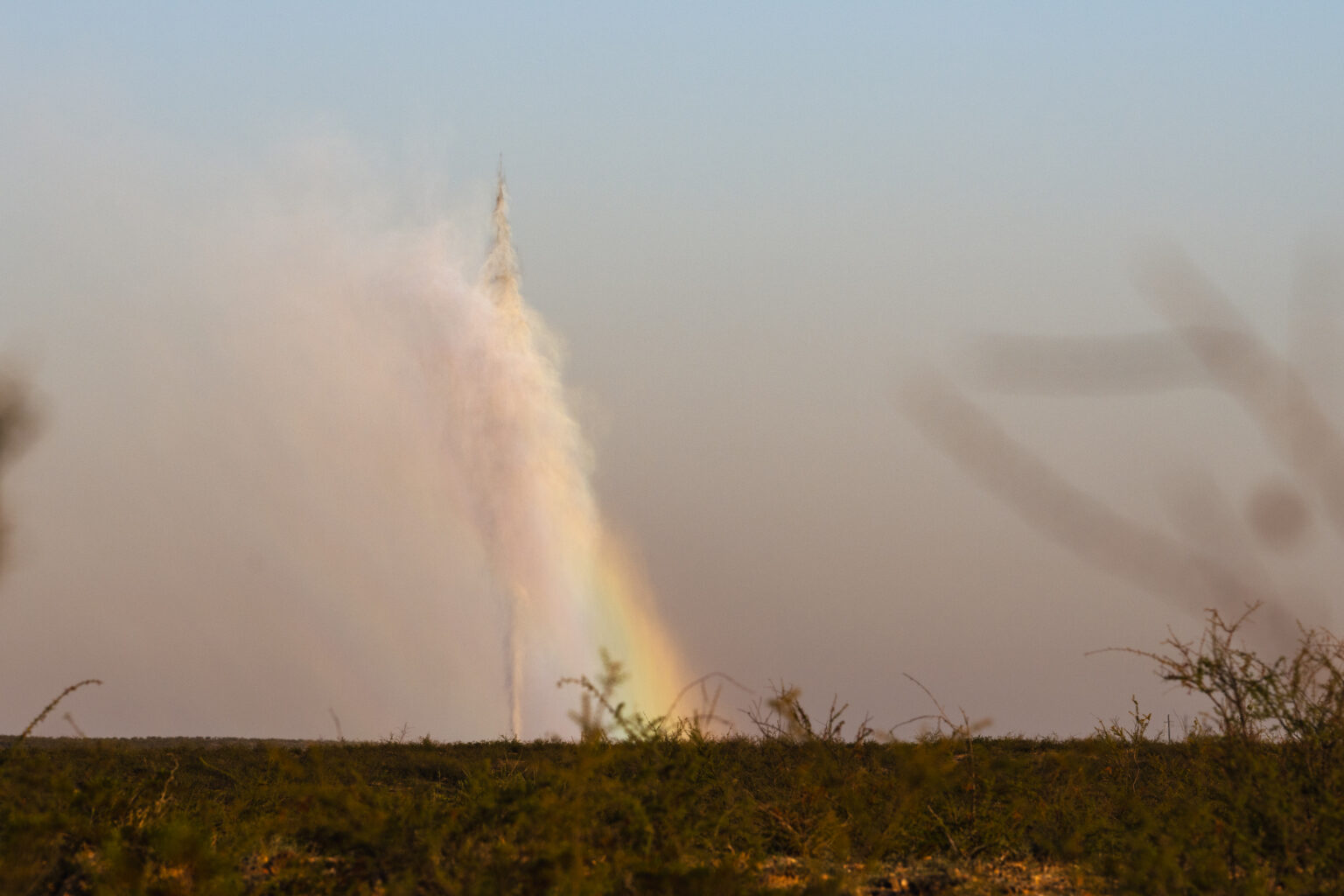**UPDATE: This story was updated at 4:45 pm ET Friday, October 4, 2024.**
All photos by Justin Hamel.
An apparent well blowout just west of Toyah created a massive geyser in the West Texas desert that was still flowing unchecked as of Friday morning, photographs reveal. DeSmog’s Justin Hammel photographed the geyser Friday morning, capturing images of an oily-appearing rainbow sheen around a tower of water over 100 feet tall.
A rotten-egg smell, a telltale hallmark of dangerous hydrogen sulfide gas, was detectable in the air from at least two miles downwind of the geyser.
Subscribe to our newsletter
Stay up to date with DeSmog news and alerts
The Texas Railroad Commission, which regulates the state’s oil and gas industry, said yesterday that the water was shooting up from a well, but the Commission was still attempting to identify the party responsible.
“It’s a ripper,” Hawk Dunlap, a libertarian candidate for the Railroad Commission, told DeSmog. “It could be coming from anywhere and it’s not going to be an easy fix.” Dunlap noted that the region where the geyser erupted has also been plagued by earthquakes amid record wastewater production in the Permian Basin.
“This is on the southern edge of the seismic response area where they have been having earthquakes from all the produced water we are injecting. 23 million barrels per day,” Dunlap posted in a TikTok video of the same geyser Thursday.
Dunlap, a long-time well control specialist and director of Well Control Management International, according to his LinkedIn bio, posted records from a 1961 well identified as belonging to El Paso Natural Gas Company, which Dunlap described as the suspected source of the blowout.
Dunlap visited the well shortly after the blowout was first reported to the local fire department, describing the fluid flowing from the well as a mix of water, salts, and light crude, plus a toxic gas that’s notorious in the Permian oilfield, hydrogen sulfide (H2S).
“I walked in as close as I could. There was high levels of H2S so I couldn’t get really close to the well,” Dunlap told DeSmog. He returned to the well, which extends down underground 11,000 feet, wearing an air tank.
“The levels of H2S on my gas monitor were exceeding the limits of the monitor, which is 200 parts per million of H2S.”
“It was extremely high in chlorides,” Dunlap said, explaining that his coveralls were salt-coated from the spray.
“In my professional opinion, I think the well had been leaking for some time and was not on anyone’s radar,” he said. As the well passes between 4,000 and 11,000 feet below ground, he added, it crosses through oil and gas production zones and wastewater injection zones, in addition to water deposits — meaning it’s possible the water could have come from a number of sources.
It wasn’t immediately clear which company currently operates or owns that well.
When reached for comment, the Texas Railroad Commission said it’s had an inspector on site since Tuesday at the uncontrolled flow from the well near Toyah, according to Patty Ramon, a spokesperson for the Commission. “We are working on identifying the responsible party for the well and contacting the operator to control it.”
Energy infrastructure company Kinder Morgan, which had representatives on the scene Thursday and today, said the blowout was unrelated to its pipeline nearby – but did not disclose whether the company owns or operates any oil, gas, or wastewater disposal wells in the area.
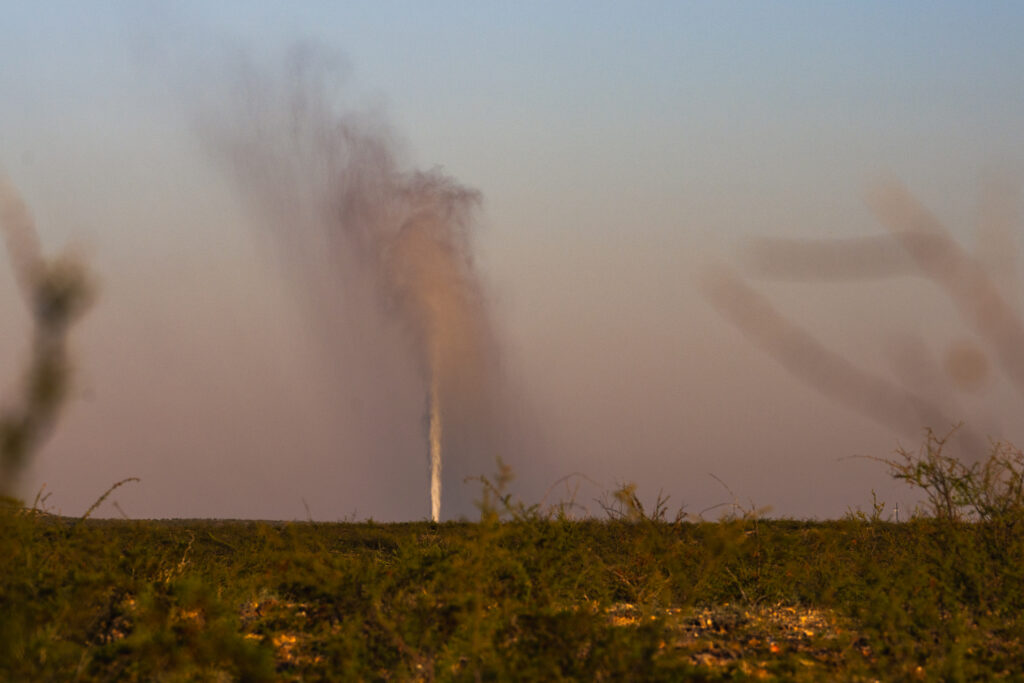
“We are aware of the situation and, while we continue to work to determine the current ownership and responsibility for this well, we are taking action to contain the product and control the well until the legal ownership/responsibility can be determined,” Katherine Hill, a Kinder Morgan spokesperson, said in a statement to DeSmog. “Our employees have determined that it is unrelated to our Kinder Morgan pipeline operations.”
Kinder Morgan fully acquired El Paso Natural Gas Company in 2013, after picking up a 50-percent share of the pipeline company in 2012.
Despite that purchase, it’s quite possible that Kinder Morgan did not actually add any oil and gas wells in the Toyah area as part of that deal.
That’s because El Paso Natural Gas’s exploration and production affiliate, EP Energy, was sold to “affiliates of Apollo Global Management, LLC and others” for $7.15 billion before Kinder Morgan acquired El Paso Natural Gas, Kinder Morgan noted as its 2012 purchase of El Paso Natural Gas closed.
EP Energy appears to have had a troubled history, at least financially. Despite its backing from the private equity giant Apollo, the firm filed for bankruptcy in 2019, seeking relief from its $4.6 billion in debt at the time – a collapse the Wall Street Journal noted was the biggest oil and gas bankruptcy in years.
There are other oil and gas companies active in the area. The geyser could be readily seen from a more modern Permian Resources well pad located near the blowout.
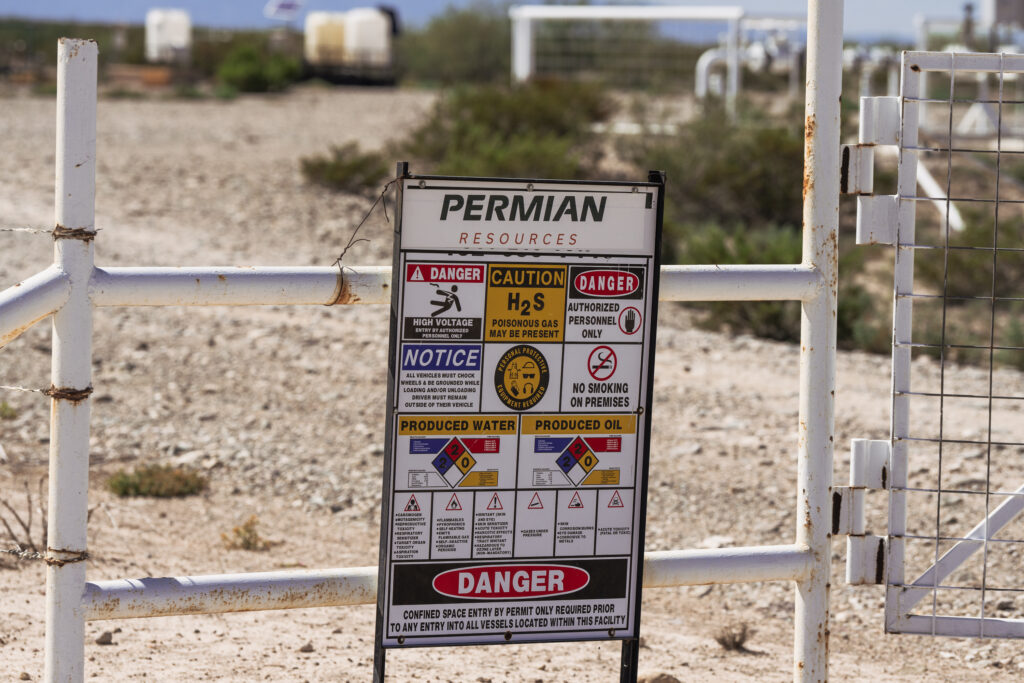
Local officials have expressed little interest in discussing the incident. “Reeves County Emergency Manager Jerry Bullard declined to comment about the geyser, saying the county has little incentive to shout it from the rooftops when such things occur because most of the county budget comes from taxes paid by the oil and gas industry,” the Houston Chronicle reported.
It was not immediately clear where the liquid spewing from the well came from, what it contained, or what caused the blowout to occur. But this part of Texas has had long-standing issues with wastewater disposal from drilling and fracking in the Permian Basin.
The amount of wastewater flowing from the Permian today dwarfs the amount of oil that flows from the same wells. The basin produced about 20 million barrels of wastewater per day in 2024, according to trade publication RBN – averaging over three barrels of wastewater for every barrel of oil.
That wastewater flood, often a toxic and briny mix of corrosive salts, water, chemicals and naturally occurring radioactive materials, has swamped the oil and gas industry’s wastewater disposal operations. Their primary method for disposing of that water is injecting it into the ground – but doing that can cause a host of issues, including earthquakes.
About a week before the Reeves County blowout was discovered, Toyah was rocked by five earthquakes in a single 24-hour period, ranging in magnitude from 2.5 to 3.8 on the Richter scale.
While earthquakes have plagued the Permian for years, wastewater blowouts may be on the rise.
A 2022 geyser in nearby Crane County was linked to oil and gas wastewater disposal, a study published in August by researchers from Southern Methodist University found. The study warned of “a potential for more blowouts in the near future.”
In the Crane County incident, the researchers wrote, wastewater from fracking had flowed underground from an injection site before bursting up from an old oil well that had been plugged and abandoned roughly 12 miles away – highlighting both the risks associated with wastewater injection and how complex it can be to trace the source of blowouts in the aftermath of incidents.
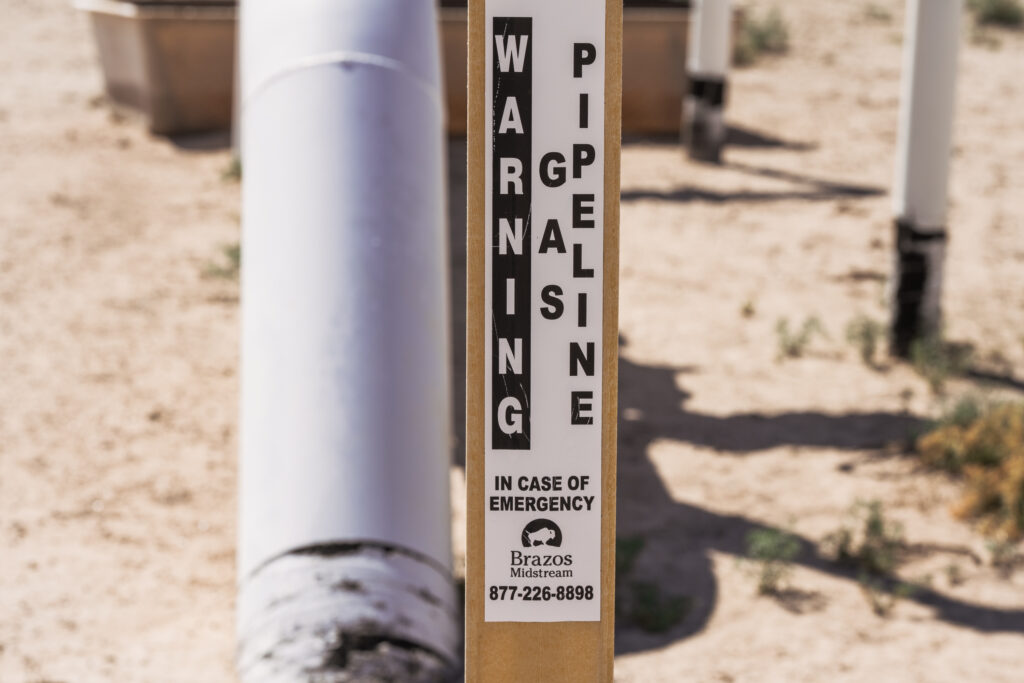

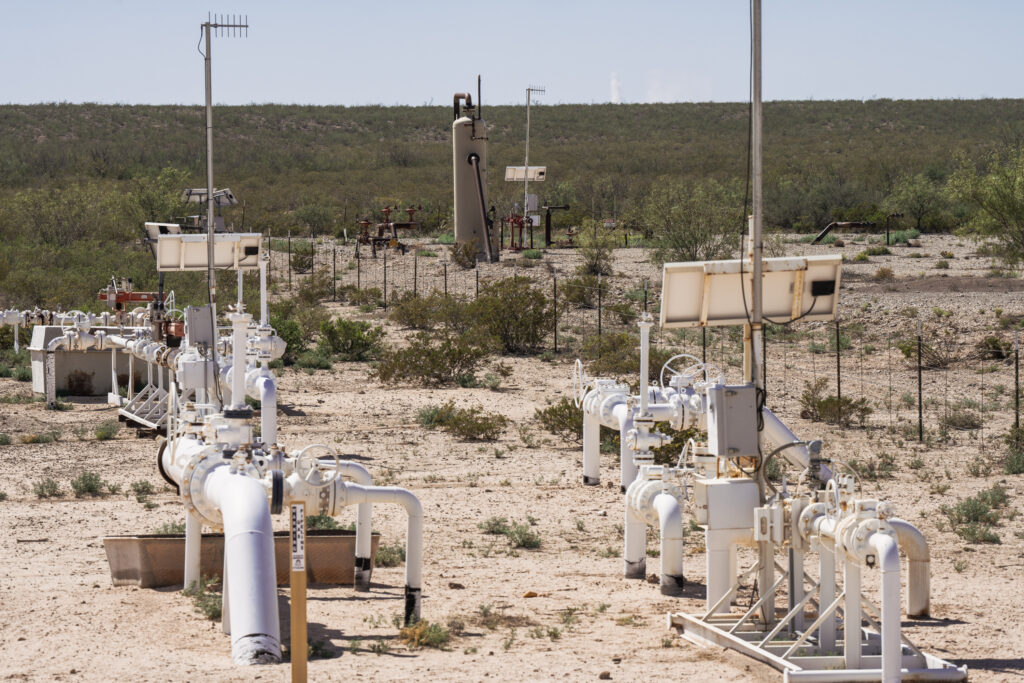
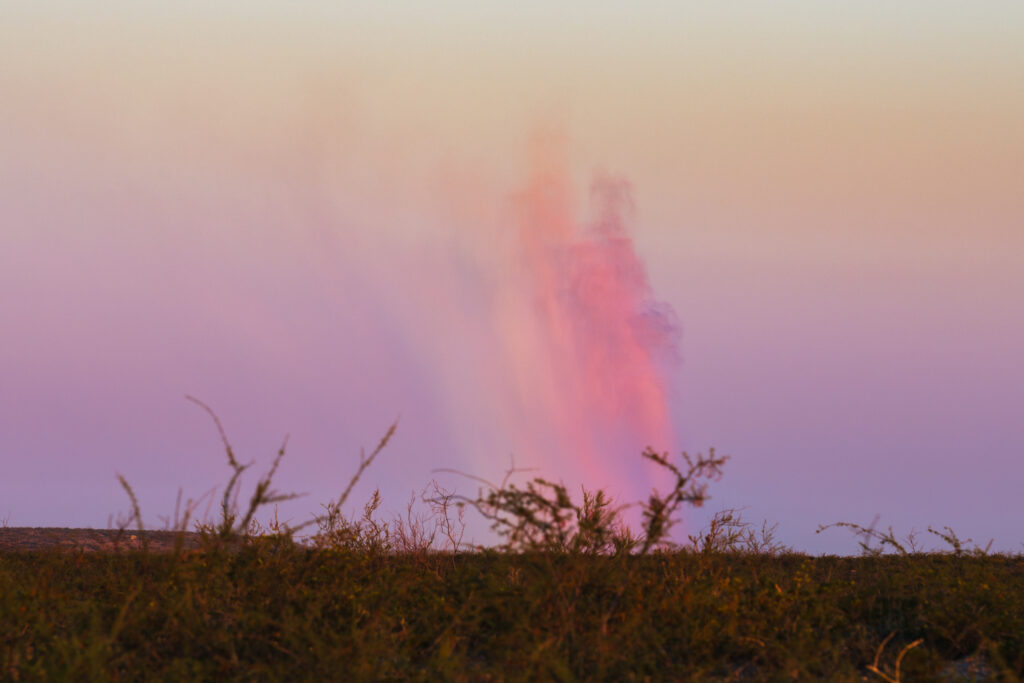
Subscribe to our newsletter
Stay up to date with DeSmog news and alerts


